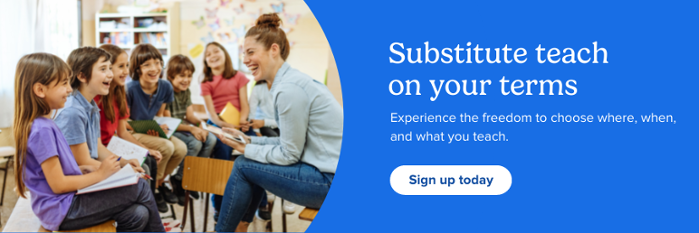
Published Oct 29, 2024
Different roles and job types within substitute teaching
Estimated Reading Time: 14 minutes
All the unique ways to take advantage of being a substitute teacher

Estimated Reading Time: 14 minutes
Substitute teaching is a diverse and rewarding profession that offers a wide range of opportunities to make a meaningful impact in the lives of students.
Whether you’re stepping into a classroom for a single day or committing to a long-term role, the flexibility of substitute teaching allows educators to tailor their careers to fit their unique skills, interests, and availability. From short-term assignments to specialized roles, such as working with students with special needs or serving as a paraprofessional, there are numerous pathways to explore within this dynamic field. Each type of substitute teaching position comes with its own set of responsibilities, challenges, and rewards, offering opportunities for growth and fulfillment at every turn.
This guide is designed to help you navigate the various ways you can serve as a substitute teacher, providing insights into the different roles available and what you can expect in each. Whether you’re considering a career change, seeking part-time work, or looking to gain experience in the education sector, this comprehensive resource will equip you with the knowledge and tools you need to make informed decisions.
Explore the possibilities, discover where your strengths align, and find the substitute teaching path that’s right for you.
In today’s fast-paced world, more people are seeking careers that offer flexibility and a better work-life balance. This shift has led to the rise of the gig economy, where workers choose temporary, project-based roles that allow them to control when, where, and how much they work.
Among the various options available in this economy, substitute teaching stands out as an ideal choice for gig workers. With the freedom to accept or decline assignments across multiple schools and districts, substitute teaching captures the essence of gig work while offering additional benefits that many other gig jobs lack.
Substitute teaching offers gig workers a unique blend of flexibility, stability, and fulfillment. Unlike many gig jobs, where work can be sporadic and unpredictable, schools always need reliable substitutes, ensuring a steady stream of opportunities. This role allows you to set your own schedule, making it perfect for those who want to balance other gigs or part-time employment.
Additionally, substitute teaching provides a chance to make a positive impact on students’ lives, explore different career interests, and build valuable professional connections. Whether you’re looking to supplement your income, give back to your community, or simply explore new opportunities, substitute teaching is an excellent side hustle that aligns perfectly with the gig economy.
A paraprofessional, often referred to as a teacher’s aide or instructional assistant, is a crucial extension of the classroom teacher, providing additional support and assistance to ensure a smooth and effective learning environment. Although they are not certified teachers, paraprofessionals play an invaluable role in the educational process. They work closely with teachers to help manage the classroom, provide one-on-one support to students, assist with lesson planning, and sometimes handle administrative tasks.
Paraprofessionals often assist students with special needs, offering tailored support that certified teachers might not have the time to provide. This individualized attention can make a significant difference in a student’s educational experience, promoting better understanding and engagement with the material.
Despite their importance, paraprofessional roles are among the highest rates of vacancies in the education sector. The high vacancy rates highlights the need for more recruitment and retention efforts to ensure that classrooms have the support they need to thrive.

Paraprofessionals assist in several key ways:
To become a paraprofessional, typically, you need a high school diploma or equivalent. Additional assessments or certifications may be required, especially for those working with special needs students. Requirements vary by state, so it’s important to research local guidelines.
Paraprofessionals are the unsung heroes of education, providing crucial support that enhances the learning experience for all students. Their patience, flexibility, and empathy make them indispensable in creating inclusive and effective classrooms.
Substitute teaching offers a unique and flexible way to engage with students and support schools, but not all substitute positions are the same. Two common roles in this field are long-term and permanent substitute teaching. While both involve stepping in for regular teachers, the responsibilities, expectations, and experiences can differ significantly.
A permanent substitute teacher becomes a regular part of a school’s staff, typically staying in one school for an entire academic year. Unlike standard day-to-day substitutes, who may be called in on short notice and work in various schools, permanent substitutes have a stable position within a single school. They fill in for teachers during absences, whether short-term (like for a professional development day) or long-term (such as for a maternity leave), and may take on additional responsibilities like assigning homework, developing lesson plans, and managing the classroom.
Permanent substitutes benefit from stability, knowing where they’ll work each day and forming deeper connections with students and staff. They also have more opportunities to develop skills in classroom management, leadership, and communication, making this role an excellent stepping stone for those considering a full-time teaching career.
Long-term substitute teachers, on the other hand, step into a specific classroom for an extended period, often covering for a single teacher who is on leave. These assignments can last several weeks or even months, allowing the substitute to become fully immersed in the classroom environment.
Because they’re in the same classroom for a prolonged period, long-term substitutes have the opportunity to build strong relationships with students and get to know the class’s routines and dynamics. This consistency helps maintain a stable learning environment, which is crucial for student success. However, long-term substitutes must be prepared to adhere closely to the absent teacher’s plans and classroom management strategies to ensure a smooth transition when the regular teacher returns.
Permanent substitute teaching offers the best of both worlds for those who enjoy variety but also crave some stability. You get to experience different classrooms and subjects without the unpredictability of last-minute calls. Moreover, staying in one school allows you to become a valued member of the school community, deepening your connections with both students and staff. This role is particularly appealing if you’re looking to grow your skills and possibly transition into a full-time teaching position.
If you’re stepping into a long-term substitute position, starting strong is crucial. Here are some tips to help you succeed:
Both long-term and permanent substitute teaching roles offer unique opportunities to make a difference in students’ lives. Whether you prefer the stability and community involvement of a permanent substitute position or the focused, classroom-specific engagement of a long-term assignment, each path has its rewards. By understanding the differences between these roles, you can choose the one that best aligns with your career goals and teaching style.

Substitute teaching in special education classes presents unique challenges and rewards. Whether you’re an experienced educator or new to the field, these essential tips will help you create a positive and inclusive learning environment for students with diverse needs. Here’s how to successfully navigate a special education classroom as a substitute teacher.
Giving yourself extra time to prepare is crucial, especially in special education settings where students rely on structure and routine. Arriving early allows you to review lesson plans, familiarize yourself with the classroom layout, and ensure that any necessary materials are ready to go.
IEPs are essential in special education, outlining the specific needs, accommodations, and goals for each student. Take time to review these documents before the day begins. Understanding the unique requirements of your students, such as medication schedules, sensory sensitivities, or behavioral triggers, will help you provide targeted support and avoid potential issues.
Collaboration is key in special education. Connect with the regular classroom teacher, special education staff, and any aides or support personnel to gather insights about the classroom dynamics and individual student needs. Clear communication ensures a cohesive approach to teaching and provides continuity for the students.
Students in special education often thrive on consistency. Establishing a clear and predictable schedule helps create a secure environment. Stick to established routines for transitions, activities, and breaks, which can help minimize anxiety and behavioral issues.
Positive reinforcement is a powerful tool in special education. Recognize and reward positive behaviors to foster a supportive classroom culture. Understand the behavior management strategies that work well with your students and apply them consistently throughout the day.
Flexibility is crucial when substitute teaching in special education. Be prepared to adapt your teaching methods and activities to accommodate various learning styles and abilities. Adjusting on the fly might be necessary to address the needs of individual students effectively.
Inclusivity is a cornerstone of special education. Encourage peer support and collaboration, and design activities that allow every student to participate at their own level. By celebrating diversity and promoting an inclusive environment, you help all students feel valued and respected.
Many students in special education classrooms have sensory sensitivities. Be aware of these needs and make necessary adjustments, such as providing sensory breaks or alternatives for students who may become overwhelmed. Creating a sensory-friendly environment can significantly enhance student comfort and focus.
Visual aids like schedules, charts, and diagrams are invaluable in special education. These tools can help clarify expectations, reinforce learning objectives, and support communication for students who may struggle with verbal instructions. Use visuals to enhance understanding and engagement in the classroom.
Take time to connect with your students on a personal level. Learn their names, interests, and preferences. Building positive relationships fosters a trusting and comfortable learning environment, making it easier for students to engage and participate in classroom activities.
At the end of the day, seek feedback from the regular teacher and special education staff. Understanding what worked well and where improvements can be made will help you refine your approach in future assignments. Continuous learning and adaptation are key to becoming an effective substitute teacher in special education.

Whether you’re taking a well-deserved break or it’s summer vacation, there are still plenty of valuable ways to spend your time off from substitute teaching. Here are some suggestions to get started:
If you find yourself missing the classroom during your break, there are plenty of opportunities to continue teaching and earning. Summer camps, tutoring centers, and online education platforms like Swing Education often hire substitute teachers for the summer months. Additionally, many schools and districts offer summer sessions that need skilled educators.
If you’re looking to try something new, consider exploring the flexibility of gig economy jobs. You can experiment with freelance work like writing, graphic design, or even ride-sharing. Balancing multiple gigs allows you to diversify your income, accommodate personal commitments, and maintain a healthy work-life balance.
All educators, including the most experienced teachers, can benefit from the right professional development exercises. As you look forward to the start of another teaching assignment, enhance your teaching skills or explore new interests that can benefit your professional life.
Substitute teaching is a rewarding profession, but by the end of the academic year, you might be ready for some well-deserved relaxation.
There are plenty of activities subs can enjoy during the summer months without breaking the bank like traveling (i.e. a staycation!), exploring the outdoors, and reconnecting with your creative side.
The summer is a good time to make sure you are up to date on your teaching certification. Each state has different requirements, but many certifications are valid for only a limited time period. For example, California’s 30-Day Emergency Substitute Teacher Permit is valid for only one year, while New Jersey’s Substitute Credential is valid for five years.
Similarly, you may need to complete a TB test/risk assessment or fingerprint on a semi-regular basis to ensure you can continue teaching.
Ultimately, whether your certification is close to expiring or if you just want to get ahead on planning, the summer presents a good opportunity to make sure you continue to have the qualifications you need.
Still need a certification? Check out our guide to getting certified in California and New Jersey.

Take some time to prepare for the upcoming school year. Get ahead:
Whether you’re supplementing your income, learning new skills, or simply enjoying some well-deserved downtime, make the most of this season. Embrace the opportunity to explore, rejuvenate, and prepare for an even better sub assignment ahead!

